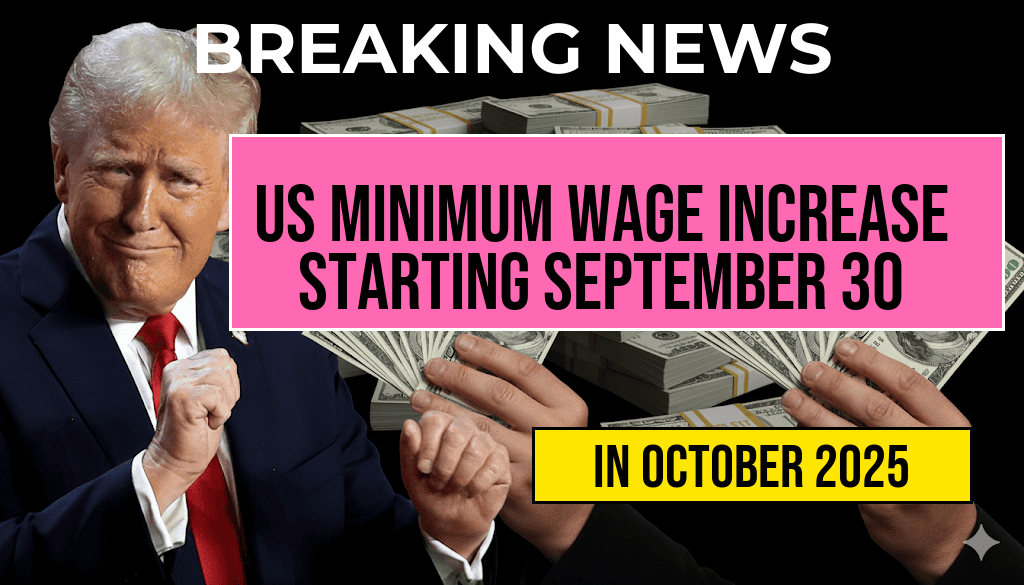The United States is set to implement a significant increase in the federal minimum wage starting September 30, 2025, marking the first sizable adjustment in over a decade. This change aims to provide increased financial support for millions of American workers, particularly those earning at or near the federal minimum. The new rates, which vary by state and locality, reflect ongoing debates about living wages and economic equity. While some regions will see substantial raises, others will experience more modest adjustments, highlighting the diverse economic landscapes across the country. This update comes amid a broader push for wage reforms, with policymakers and labor advocates emphasizing the importance of ensuring fair compensation amid rising living costs. The following comprehensive list details the new hourly rates across different jurisdictions and the factors influencing these changes.
Federal Minimum Wage Adjustment and Its Implications
Effective September 30, 2025, the federal minimum wage will rise from $7.25 to $10.50 per hour. This adjustment is mandated by recent legislative action aimed at gradually increasing wages to better align with inflation and cost-of-living increases. Although the federal baseline sets the minimum, individual states and localities often implement higher rates based on regional economic conditions and legislative measures. The increase is expected to benefit approximately 3.5 million workers nationwide, many of whom have faced stagnant wages amidst rising expenses for housing, healthcare, and education (see Wikipedia’s overview of minimum wage laws).
State and Local Variations in the New Rates
While the federal minimum sets a nationwide floor, several states and cities have predetermined higher minimum wages, which will also be adjusted on or around September 30, 2025. These local rates often surpass federal standards, reflecting regional economic conditions and political priorities. The following sections detail the updated hourly rates in key jurisdictions.
States with the Highest Minimum Wages
| State | New Minimum Wage | Notes |
|---|---|---|
| California | $16.00 | Rate applies statewide; scheduled increases planned through 2026 |
| Washington | $15.75 | Includes regional adjustments for Seattle and surrounding counties |
| Massachusetts | $15.00 | Part of a phased increase started in 2018 |
| Oregon | $14.75 | Varies by region; Portland’s rate is higher |
States with Modest Increases
- Florida: $11.00 per hour, up from $10.50
- Arizona: $13.50 per hour, up from $12.80
- Colorado: $14.00 per hour, up from $13.85
States Maintaining the Federal Minimum
- Alabama: $7.25 (no change)
- Georgia: $7.25 (no change)
- Wyoming: $7.25 (no change)
These disparities highlight ongoing debates about the adequacy of the federal minimum wage and the role of states and municipalities in setting their own standards. Many advocates argue that higher minimum wages are necessary to address economic inequality, while opponents caution about potential impacts on business competitiveness and employment levels.
Legislative and Policy Context
The scheduled increase follows years of advocacy from labor organizations and progressive policymakers, seeking to align wages with inflation and the rising cost of living. The federal legislation that mandated this adjustment reflects the culmination of bipartisan efforts to support low-wage workers. Notably, some states and cities have opted to implement even higher minimum wages through local ordinances, often citing the need for economic justice and improved quality of life for their residents (additional background).
Economic Impact and Future Outlook
Economists remain divided on the long-term effects of minimum wage hikes. Proponents argue that increased earnings boost consumer spending, stimulate local economies, and reduce reliance on social safety net programs. Conversely, critics warn of potential job reductions or increased automation as businesses adjust to higher labor costs. The upcoming wage adjustments will serve as a test case for evaluating these impacts in different regional contexts.
Looking ahead, discussions about further increases are already underway, with some policymakers advocating for a federal minimum that approaches $15 per hour nationwide. As inflationary pressures persist, the debate over a living wage continues to shape the legislative landscape, influencing both political discourse and economic policy decisions (Forbes analysis).
Frequently Asked Questions
What is the effective date of the new U.S. minimum wage rates?
The new U.S. minimum wage rates will become effective on September 30, 2025.
Which states or regions are affected by the minimum wage increase?
The full list of new hourly rates applies to specific states and regions across the United States, as detailed in the official announcement.
How much will the minimum wage increase in different areas?
The hourly rates will vary by state or region, with each area’s new minimum wage specified in the official list to reflect local economic conditions.
Are there any exemptions or special considerations in the new minimum wage law?
Yes, certain exemptions or special provisions may apply depending on the industry, employer size, or employee classification, as outlined in the detailed regulations.
Where can I find the complete list of the new hourly minimum wages?
The full list of new hourly rates is available in the official government publication and on the relevant state or federal labor department websites.

Leave a Reply